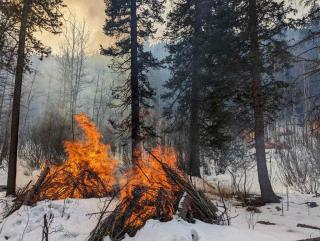Keystone investments at work
COLORADO—Partners have been, and remain, an essential part of implementing the Wildfire Crisis Strategy. Working collaboratively with local and national partners, forests across the nation have been able to increase the pace and scale of wildfire risk reduction work in the communities where it’s needed most.
This winter, the WCS Colorado Front Range Landscape worked with The Nature Conservancy to reduce fuels accumulated from thinning operations on the Arapaho and Roosevelt National Forests and Pawnee National Grassland and Pike-San Isabel National Forests & Cimarron and Comanche National Grasslands. Over the course of 81 days, several TNC modules worked alongside Forest Service fire personnel to burn 16,500 slash piles, treating a substantial 778 acres.
Slash piles are strategically placed stacks of wood left behind after thinning operations. They are only burned when weather conditions allow for adequate snow cover and good smoke dispersal. Because of weather variability, crews needed to be adaptable during their time on the Front Range. When burning was not feasible on the Pike-San Isabel National Forests & Cimarron and Comanche National Grasslands, crews assisted in the construction of hand line around two upcoming broadcast burn units. The Nature Conservancy was instrumental in the success of approximately two miles of hand line constructed around the 70-acre and 400-acre units.
“The Nature Conservancy’s prescribed fire module members provided help at a crucial time during the winter burn window, which aided our success this pile burning season. It is a great asset to the forest when self-driven resources come in, and TNC module members demonstrated that time and time again,” said Jarred Gordon, task force leader for the PSICC’s Harris Park prescribed pile burn project.
This adaptability is indicative of the long-term benefits of this partnership on the landscape. In addition to reducing hazardous fuels in preparation for this fire season, crews are also developing skillsets that contribute to future mitigation, fuels reduction and firefighting capacity. By working with crews from outside the Forest Service, we can cultivate a larger national resource that is well-equipped to respond in times of need and help us treat acres to reduce risk year after year.
“It was a pleasure working with the TNC crews, who were consistently positive, inquisitive and professional. Their diligence in securing our burn piles was very much appreciated by our neighbors and partners and we look forward to being able to work with them again in the future,” said Nate Hallam, assistant fire management officer for the South Zone of the Arapaho and Roosevelt National Forests and Pawnee National Grassland.
This work was completed as a part of a new portfolio of agreements between the Forest Service and TNC, executed in summer/fall 2023. This national-level partnership, funded primarily by the Inflation Reduction Act, focuses on implementing the Wildfire Crisis Strategy and reducing fuels, restoring forests and mitigating impacts of climate change across the country. Through a keystone investment with TNC, national forests across the country can develop relationships with TNC and request personnel to support prescribed fire and fuels reduction activities, augmenting our capacity to implement this priority work.
“The Nature Conservancy’s longstanding working relationships with the ARP and PSICC set the stage to leverage these historic federal investments and turn opportunity into action. While TNC and the USFS have been collaborating for years to plan and implement projects across the two forests, the keystone investment has significantly ramped up our collective ability to accelerate use of beneficial fire in the WCS Colorado Front Range Landscape,” said Parker Titus, fire program manager for The Nature Conservancy in Colorado.
The Colorado Front Range Landscape encompasses 3.6 million acres, 80 at-risk communities, 156 watersheds, and nine miles of 345+ volts transmission lines across two national forests. In the first two years of Wildfire Crisis Strategy implementation, the Arapaho and Roosevelt National Forests and Pawnee National Grassland and PSICC have collectively treated over 30,000 acres alongside many partners and communities. Looking to the future, we look forward to continuing work with these partners that are critical to the success of WildfireCrisis Strategy implementation in the Rocky Mountain Region.


